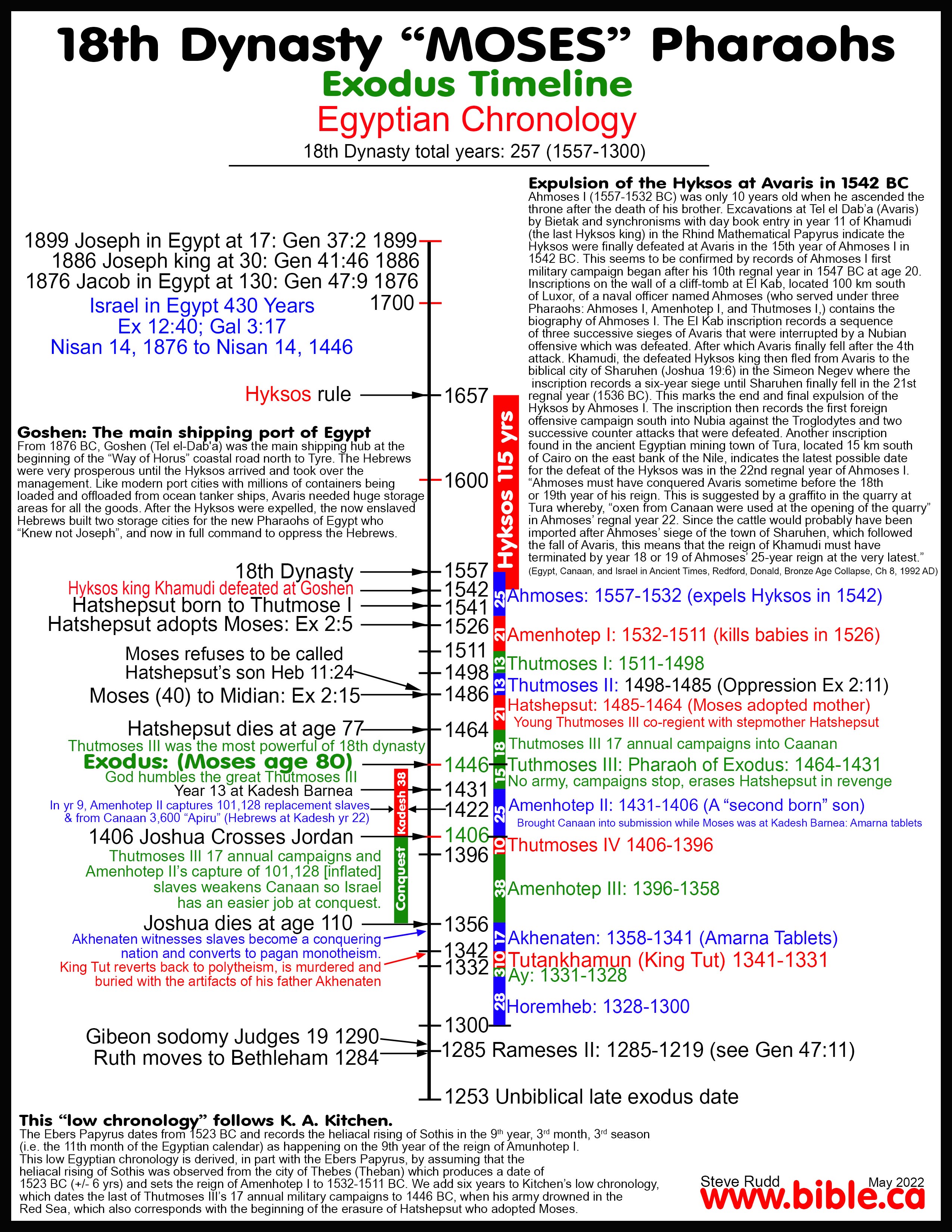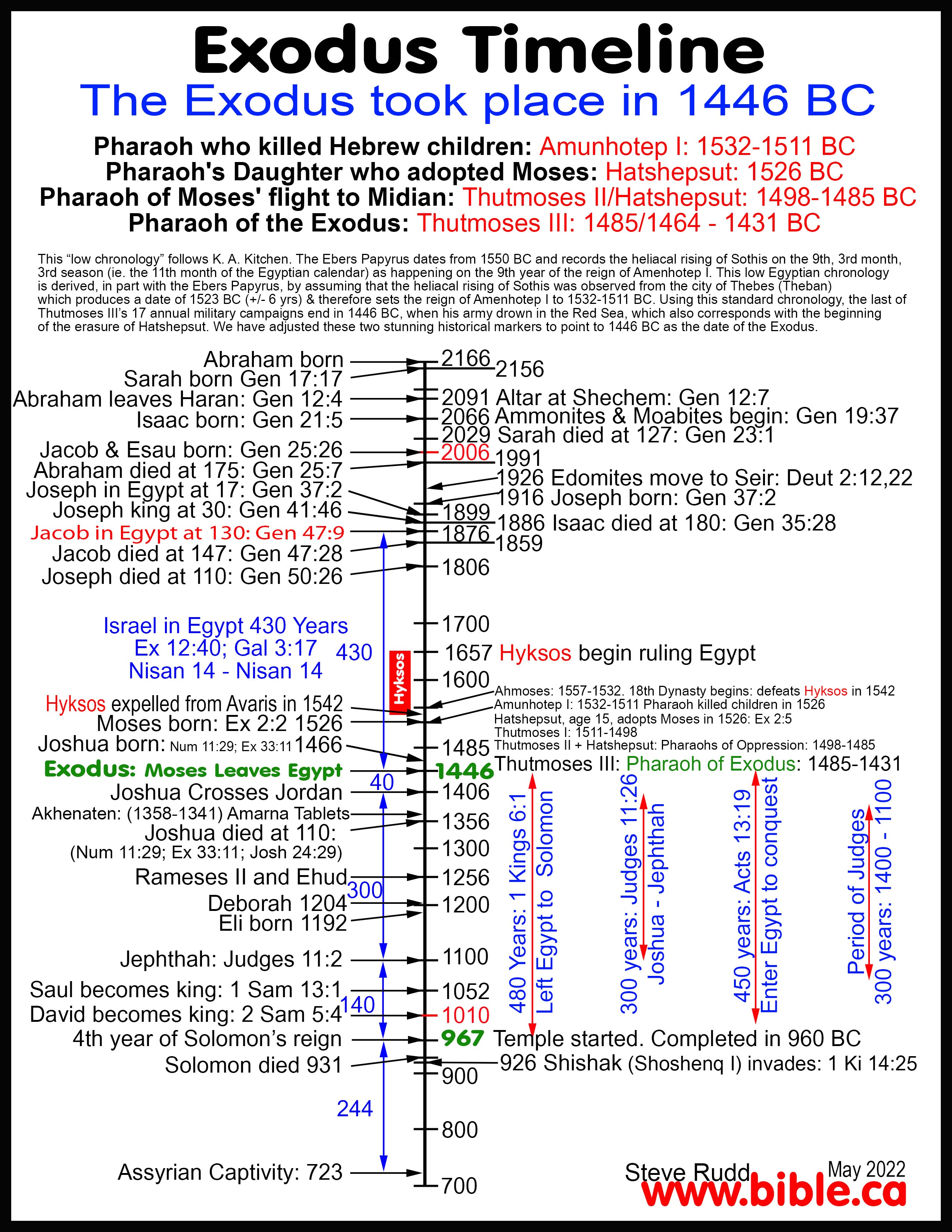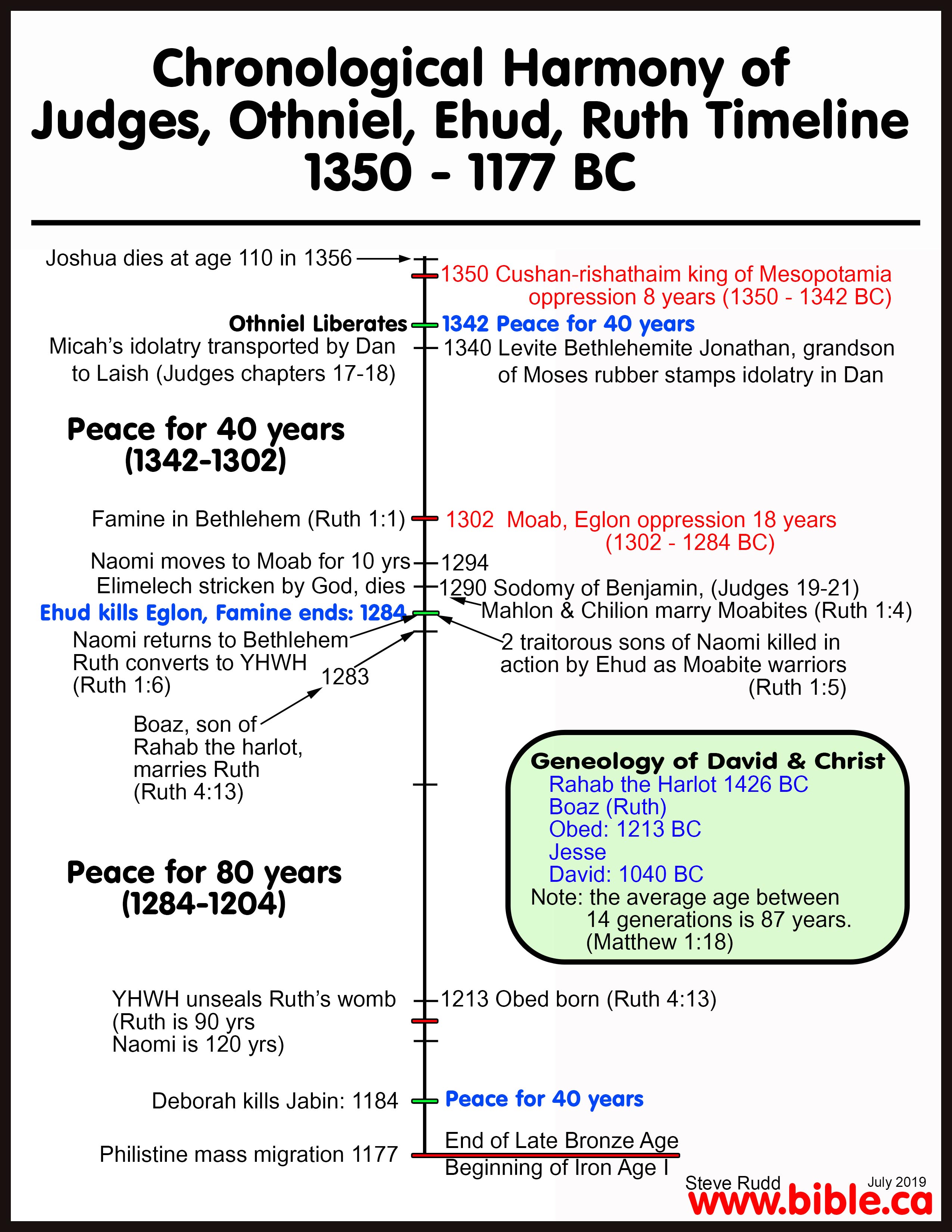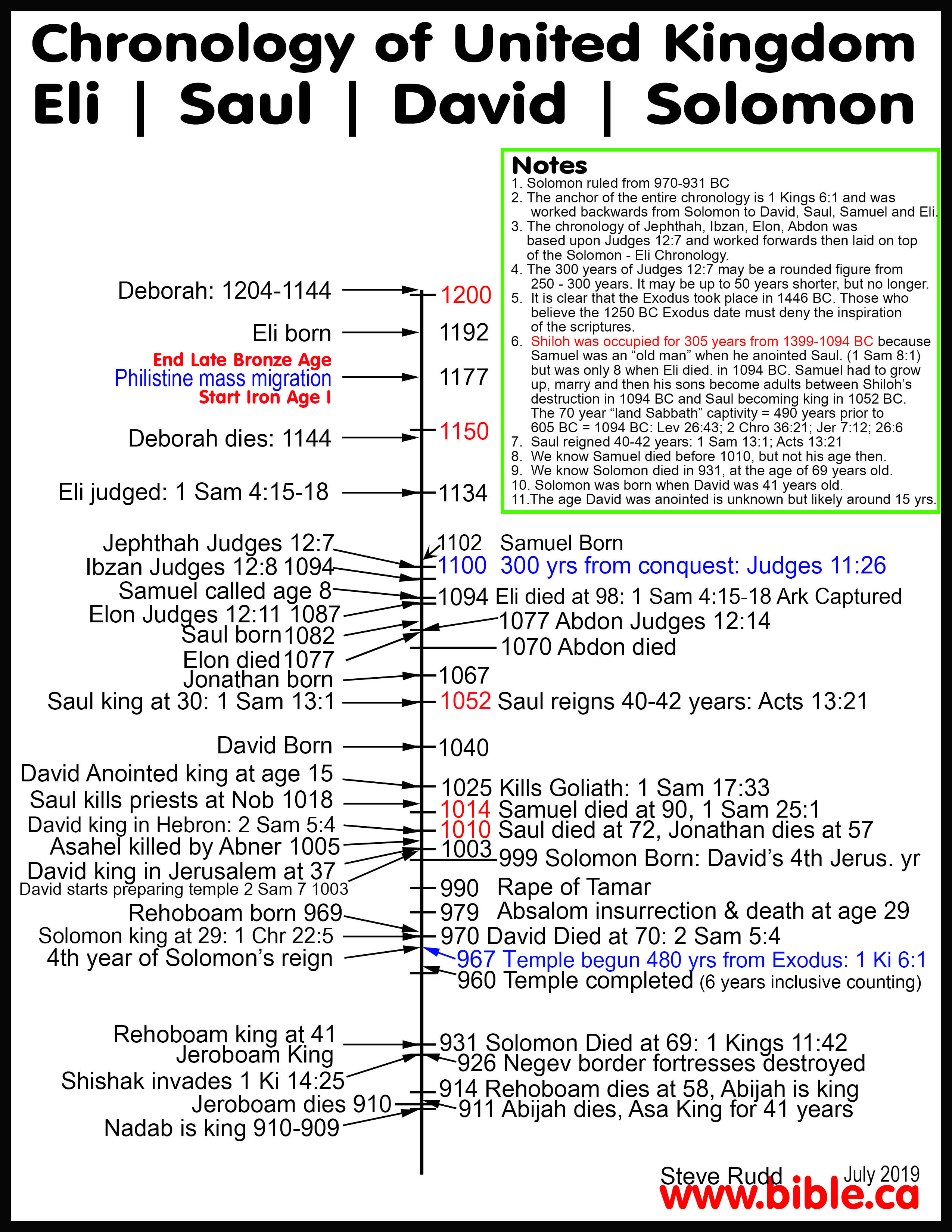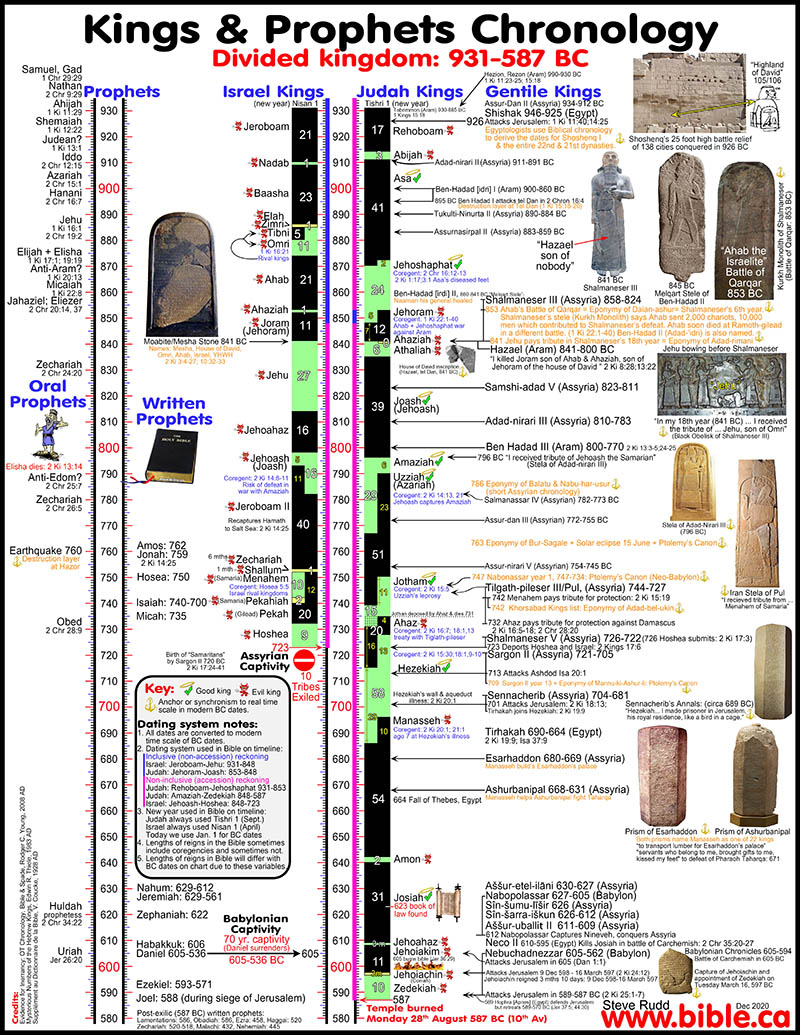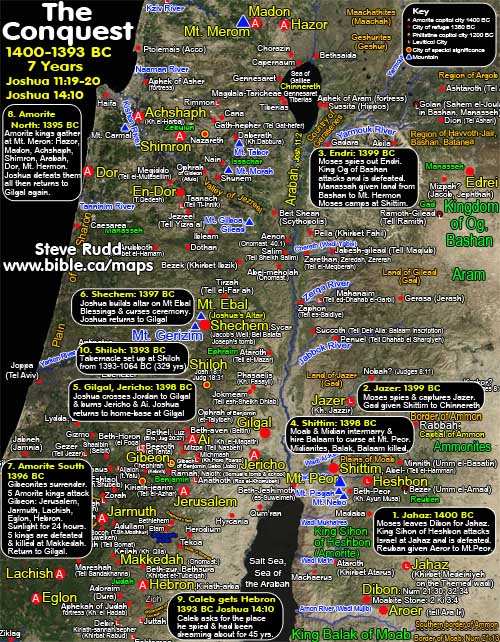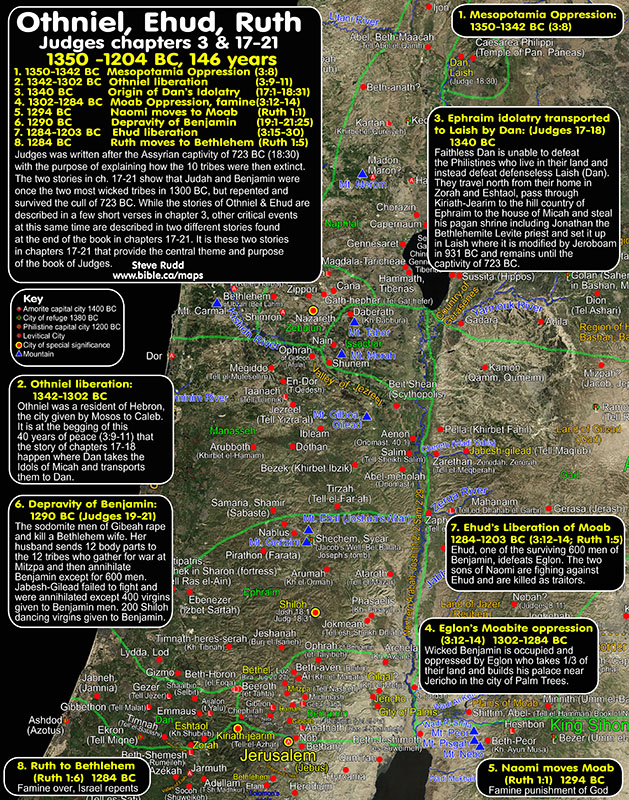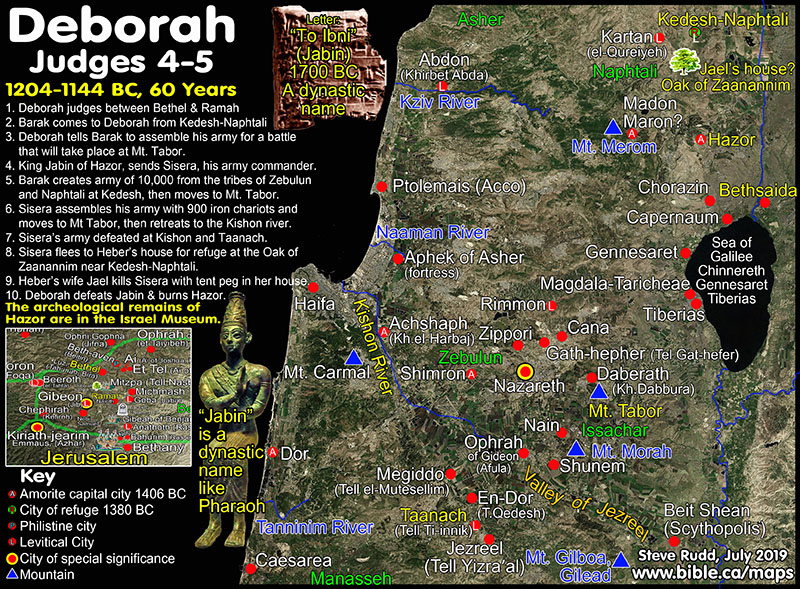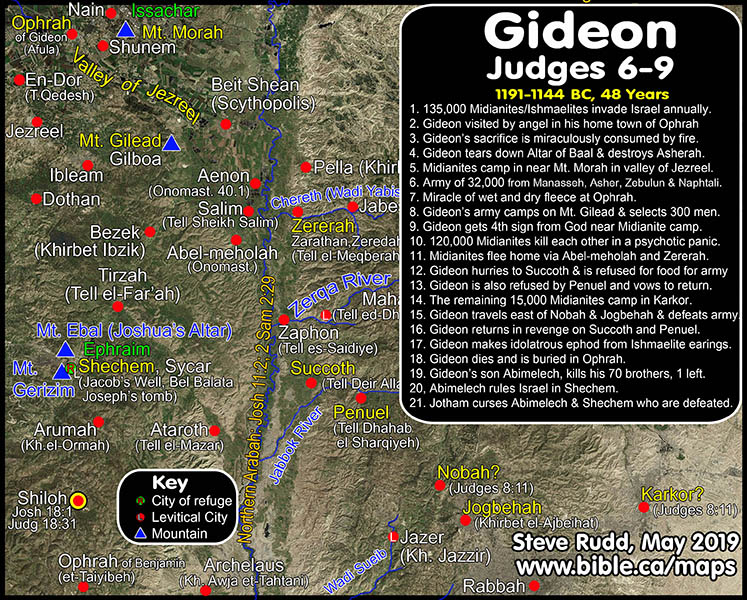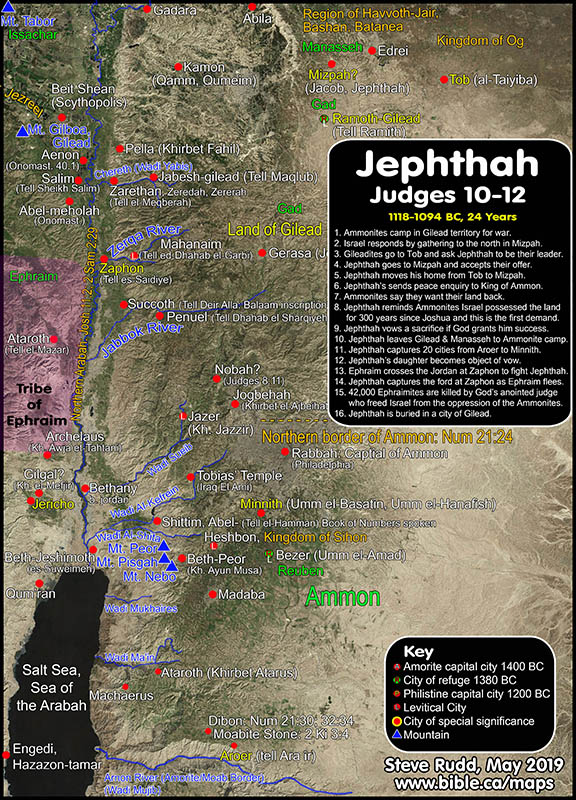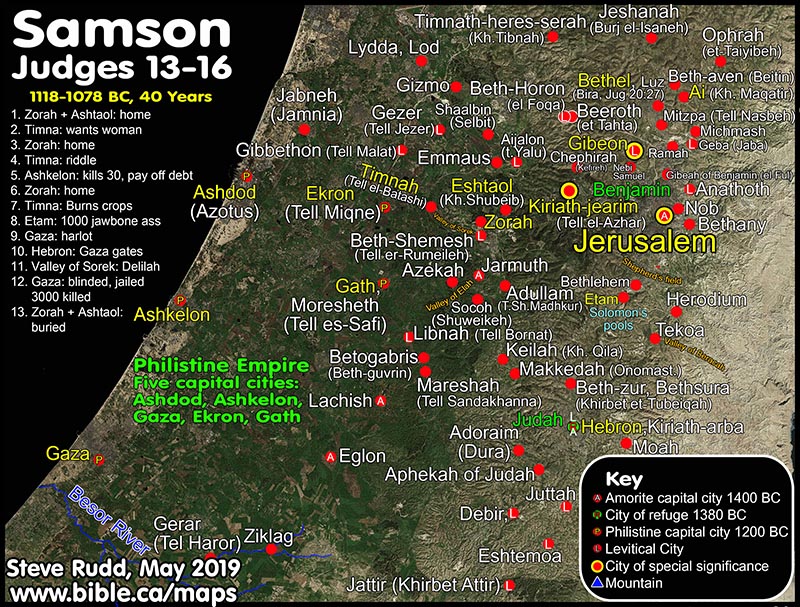The Chronology of Judges solved!
1350 - 1014 BC for a total of 336 years.
1 Kings 6:1 Exodus to Solomon’s 4th year = 480 Years
Exodus to Conquest: 40 years (1446-1406 BC)
Conquest to death of Joshua: 50 years (1406-1356 BC)
Death of Joshua to first Judge: 6 years (1356-1350 BC)
First Judge to death of Samuel: 336 years (1350-1014 BC)
Death of Samuel to Death of Saul/David king: 4 years (1014-1010 BC)
David king 40 years (1010-970 BC)
Temple Year 4 of Solomon (970-967 BC)
40 + 50 + 6 + 336 + 4 + 40 + 4 = 480 years = 1 Kings 6:1
Maps of Judges, Timeline of Judges
Sermons and Outlines of Judges
Archeological evidences of Judges
|
Old Testament Chronology and Timelines |
||||||
|
Chronology of the Flood outline |
Chronology of Egypt outline |
Chronology of the Exodus outline |
Chronology of Judges outline |
Chronology of Ruth outline |
Chronology Eli-Solomon outline |
Chronology of Kings outline |
|
Judges Sermon Outlines |
||||||
|
Conquest |
Othniel, Ehud, Ruth |
Deborah |
Gideon |
Jephthah |
Samson |
Eli, Samuel, Saul, David |
|
1406-1399 |
1350-1204 |
1204-1144 |
1191-1144 |
1118-1094 |
1118-1078 |
1128-1004 |
|
Josh 1-15 |
Judges 3, 17-21, Ruth |
Judges 4-5 |
Judges 6-9 |
Judges 10-12 |
Judges 13-16 |
1 Samuel 1-31 |
|
Canaanites |
Mesopotamia, Edom |
Hazorites |
Ishmaelites, Midianites |
Ammonites |
Philistines |
Philistines, Ammonites, Amalekites |
The Chronology of Judges solved!
Other related outlines:
1. Harmony of Othniel, Ehud, Judges 17-18, Judges 19-21 and Ruth
2. Book of Ruth: Ruth and Boaz lived in the time of Ehud: 1300 BC
3. Chronology of the book of Judges solved
Introduction:
- The period of the judges is 1350 - 1014 BC for a total of 336 years.
- The chronology of the book of Judges has been a problem because when you add up all the numbers and dates given in the book of Judges the sum of years is about 100 years more than what it should be.
a. The key in using the period of the Judges to determine the exodus date of 1446 BC, is that it must be more than 300 years (Judges 11:26-28) and less than 410 years.
b. Either way it clearly refutes an exodus of 1250 BC and that is all we are concerned about in this section on the Judges.
- The death of Joshua in 1356 BC is a critical anchor point for beginning the Chronology of the Judges.
a. Joshua lived 1466 - 1356 BC: Joshua is described as a young man, a youth and was about 20 years old when Israel left Egypt in 1446 BC: (Ex 33:11; Num 11:28). Joseph was called "a youth" at age 17: Genesis 37:2. Joshua was chosen by Moses to fight Amalek at (Exodus 17:9) Rephidim. It is truly remarkable that a 20 year old was given the responsibility of leading the armies of Moses. Since the exodus was 1446 BC and Joshua lived to be 110 years old. (Joshua 24:29) This means Joshua was born about 1466 BC and died 1356 BC. This means that Joshua began serving Moses at age 18-20, and served Moses for 40 years in the wilderness and then 50 years in Canaan after crossing the Jordan.
b. The first Judge arose only after Joshua died in 1356 BC (Judges 1:1). Samuel was the last judge who died in 1014 BC, which was four years before David began to reign in 1010 BC. The formal period of the Judges is from 1350 - 1014 BC for a total of 336 years. 1 Samuel tell us that Eli and Samuel were the two last judges, even though he is not mentioned in the book of Judges.
c. Some set the death of Joshua at 1384 BC and a date of 1378 BC for the oppression of Cushan-Rishathaim king of Mesopotamia (Josh 3:8). This 29-year error has the direct effect of shifting the entire Chronology of the Judges 29 years earlier than it should be. This 29-year error causes dissonance with the date Deborah burned Hazor, the Merneptah Stele, the collapse of the Late Bronze age with the mass arrival of the Philistines, the burning of Shiloh and the birth of King David.
- Chronological calculations:
a. Samuel died in 1014 BC and Saul died the same year David became king in Hebron in 1010 BC. The Judgeship of Samuel completely overlapped the reign of Saul. While we often view the period of the judges ending with the day Saul became king, the Bible says that Samuel Judged Israel all the days of his life. Saul died within a year after Samuel's death. The last judge was Samuel and the first king was David. It is important to remember that the period of the Kings began with the anointing of Saul and the period of the Judges ended with the death of Samuel.
b. When can use Jephthah's statement in Judges 11:26, that he lived 300 years (1100 BC) after Israel crossed the Jordan, as an anchor to adjust the chronology of the book of Judges into real time. We accept that when Jephthah said it had been 300 years since Israel crossed the Jordan, it was likely a rounded figure. However it is clear that the literal period of time when Jephthah said 300 years, must have been somewhere between 275 - 300 years. For the purposes of chronology, we really have no choice but to use 300 years as the time Jephthah made this statement and this is what we have done.
c. The chronology found in the book of Judges begins with Othniel and ends with Abdon who died about the same time as Eli. Samson lived at the same time as Jephthah so Abdon judged after him in chronological terms) This literal period of time that the book of Judges deals with therefore, is 281 years from the death of Joshua in 1356 BC to the death of Abdon in 1069 BC. (Eli died in 1088 BC).
d. We know that Shamgar judged at the same time as Deborah because both of their judgeships are described as "after Ehud".
- The chronology of the Judges reveals some spectacular synchronisms with the Bible and archaeology:
a. Eglon and Ruth in 1284 BC: Ehud killed Eglon in 1284 BC, the same year Ruth and Naomi returned to Bethlehem. The husbands died in the book of Ruth because they had joined the Moabite army and were killed by the Israel.
b. Merneptah Stele in 1205 BC: Although not recorded in the Bible, the Merneptah Stele documents Egypt’s invasion of Israel in 1205 BC, precisely at the end of the 80 years of Peace under Ehud (1204 BC) and at the begging of the oppression of the Canaanites in Judges 4:3 from 1204-1184 BC. Notice that those who misdate the death of Joshua to 1384 BC (29 years too early), put the Merneptah Stele in 1205 BC directly inside the 40 years of peace under Deborah which started in 1213 BC. The Merneptah stele fits perfectly with high precision in the Judges chronology when you set the date of Joshua correctly at 1356 BC.
c. Deborah burns Hazor in 1184 BC: Deborah burned Hazor in 1184 BC. Deborah’s final liberation act of burning Hazor was at the beginning of the 40 years of peace in 1184 BC. The 20 years of oppression under the Canaanites started in 120 and ended in 1184 BC. Those who misdate the death of Joshua to 1384 BC (29 years too early) make a double mistake in dating Deborah’s burning of Hazor. They misdate Deborah’s burning of Hazor to the beginning of the 20-year Canaanite oppression in 1204 BC rather than the end in 1184 BC. When you add these 20 misdated years to the 29-year error of when Joshua died, it is easy to see how their date for the burning of Hazor by Deborah in 1230 BC is a whopping 46 years too early.
d. Deborah and Gideon concurrent 40 years of peace: A spectacular chronological discovery is that Deborah and Gideon delivered Israel from two different armies 30 km apart the same year. Deborah’s battle at Mt Tabor and Gideon’s army 30 km south at Mt Gilead happened the same year. We have a synchronism between Deborah and Gideon because their respective 40 years of peace of began in 1184 BC and end in 1144 BC. It was during these 40 years of peace that Philistines arrived in Judah in 1177 BC in 8th yr. of Ramesses III. Although Deborah is in Indivisible Chronology Unit #1 and Gideon is in Indivisible Chronology Unit #2 each defeated a different enemy of Israel the same year, using the same tribal armies of Zebulun and Naphtali. Both Deborah and Gideon completed their liberation the same year in 1184 BC. Deborah began to fight the king of Hazor in central Israel at Mt Tabor then the battled moved north to Hazor. Gideon’s famous army of 300 defeated the annual incursion of the Midianites and Amalekites at Mt. Gilead which is 30 km south of Deborah’s battle at Mt. Gilead. When the Midianites fled Transjordan, Gideon pursued them towards Amman and defeated them. This is confirmation that our approach is correct.
e. Philistines trigger the Collapse of the Late Bronze Age in 1177 BC: The LB age ended in 1177 BC, which marked the beginning of the Iron Age. This well documented event is recorded in the wall reliefs of pharaoh Ramesses III when in year 8, there was a mass immigration of the Philistines into Canaan. Deborah witnessed the arrival of the Philistines and the collapse of the LB age in times of peace. During Deborah’s 40 years of peace which ended in 1144 BC in northern Israel, the Philistines were establishing themselves in southern Israel, but did not start oppressing Judah until 1118 BC. Samson battled the Philistines (Judges 13:1) during the entire 40 years they oppressed Judah until he died in 1078 BC. It would not be until the time of David that the Philistines were fully subdued.
f.
Burning of Shiloh in 1094 BC: Bible chronology dates the burning
of Shiloh to 1094 BC by the birth of David in 1040 BC and by using the 70-year
Babylonian captivity as a penalty for not keeping the sabbath for the 490 years
(70 years of captivity = 70 sabbath-weeks = 490 years) that preceded
Nebuchadnezzar’s first attack in 605 BC (605 BC + 490 years = 1094 BC). See Lev
26:43; 2 Chron 36:21; Je 7:12-14; 25:12; 26:4-9; Dan 9:2; Zech 1:12. The author
is staff archeologist at Shiloh and in the 2019 season of excavations it was
confirmed that the Philistines burned the city even though scripture is silent
on whether Shiloh was actually burned by the Philistines.
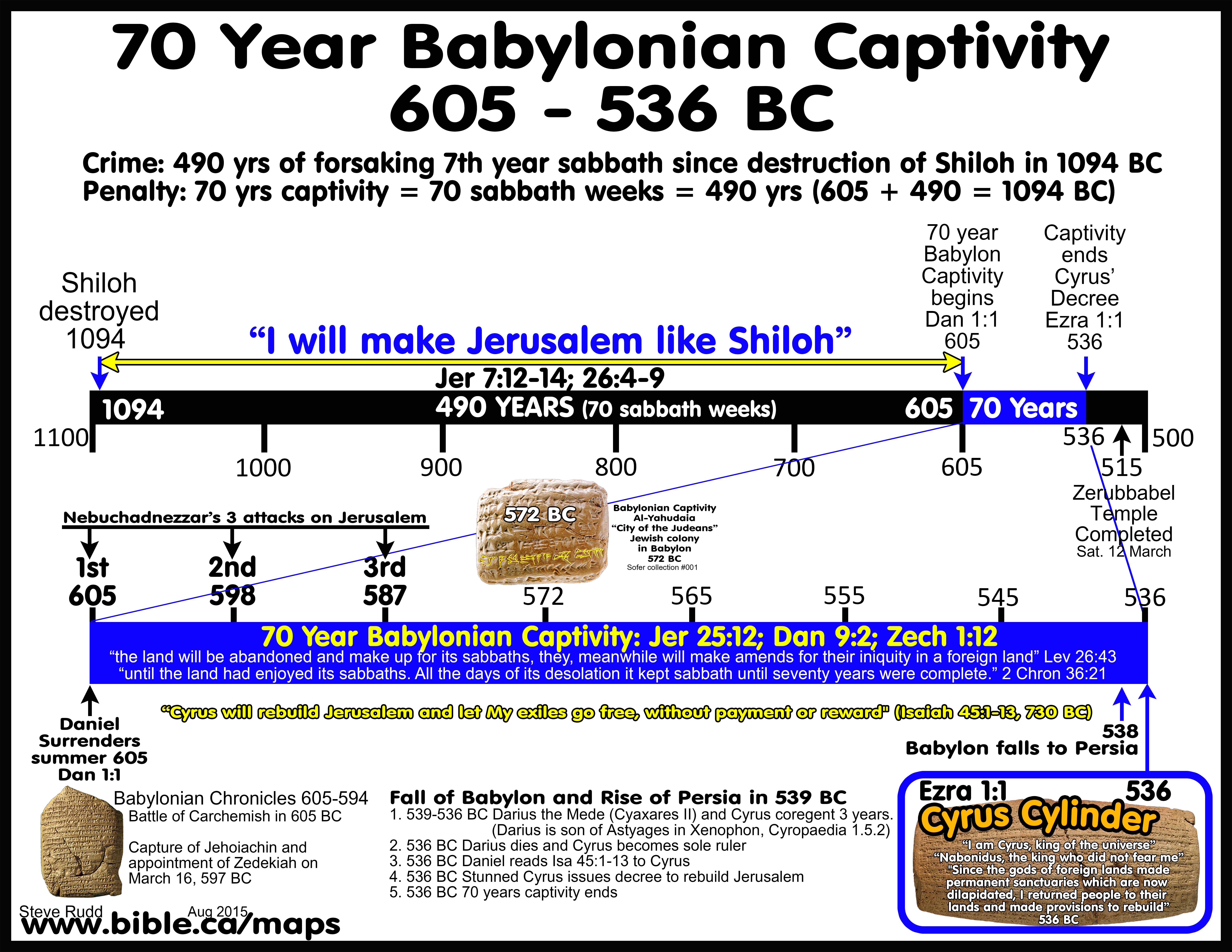
g. Perhaps most remarkable is the fact that 1094 BC not only marks the destruction of Shiloh, it also marks the end of peace under Jair’s and Jephthah’s judgeship in Transjordan Gilead. In other words, there is a triple Bible synchronism where oppression starts in 1094 BC.
i. In 1094 BC, oppression begins in Israel and Judah when the Philistines burn Shiloh.
ii. In 1094 BC, oppression begins Transjordan in Gilead when both Jair and Jephthah die two years apart.
6. When you get the chronology right, the cartography right and the archaeology right, you get the Bible text right!
A. The Chronology of Judges Master Table:
1. Each judge completed their liberation from oppression at the beginning of the years of peace. This means that the judges began their work as liberators during the periods of oppression and completed the liberation the year the oppression ended, and the years of peace began.
|
Oppressor: years |
A |
Area of Israel affected |
Judge: years |
Tribes involved in fighting |
B |
A+B |
Date BC |
Indivisible units |
|
Aram-naharaim: (3:8) Oppressed 8 yrs. 1350-1342 BC |
8 |
- |
Othniel: (3:11) Peace 40 yrs. 1342-1302 BC |
Hebron |
40 |
48 |
1350 - 1302 |
Unit 1: |
|
Moabites: (3:14) Oppressed 18 yrs. 1302-1284 BC |
18 |
Central Merneptah Stele (1205 BC) |
Ehud: (3:30) Eglon killed in 1284BC. Ruth & Boaz move to Bethlehem in 1284 BC Peace 80 yrs. 1284-1204 BC |
Benjamin |
80 |
98 |
1302 - 1204 |
|
|
Philistines: (3:31) |
- |
Southern Merneptah Stele (1205 BC) |
After Ehud came Shamgar: (3:31) |
Many |
- |
- |
1200 |
|
|
after Ehud died, Canaanites: (4:3) Oppressed 20 yrs. |
20 |
Central to North, Mt. Tabor to Hazor Merneptah Stele (1205 BC) |
Deborah: (5:31) Mt. Tabor then Hazor burned in 1184 BC peace 40 yrs. 1184-1144 BC |
Zebulun, Naphtali |
40 |
60 |
1204 - 1144 |
|
|
Midianites, Amalekites: (6:1) Year invasion. Oppressed 7 yrs. 1191-1184 BC |
7 |
Central to Gilead: Starts in Jezreel Valley then Transjordan |
Gideon: (8:28) Gideon’s army at Mt. Gilead in 1184 BC. Peace 40 yrs. 1184-1144 BC |
Manasseh, Asher, Zebulun, Naphtali |
40 |
47 |
1191-1144 |
Unit 2: Bronze age ends in 1177 BC. Philistines arrive in 1177 BC in 8th yr. of Ramesses III. |
|
- |
- |
- |
Abimelech: (9:22) After Gideon |
Shechem |
3 |
3 |
1144 - 1141 |
|
|
- |
- |
- |
Tola: (10:2) After Abimelech |
Ephraim |
23 |
23 |
1141 - 1118 |
|
|
- |
- |
Transjordan |
Jair: (10:3) After Tola |
Gilead |
22 |
22 |
1118 - 1096 |
|
|
Ammonites: (10:8) Oppressed 18 yrs. 1118-1100 BC |
18 |
Transjordan |
Jephthah: (12:7) Judged 6 yrs. 1100-1094 BC Shiloh burned in 1094 BC |
Gilead |
6 |
24 |
1118 - 1094 |
Unit 3: |
|
- |
- |
- |
Ibzan: (12:8) after Jephthah judged 7 |
Bethlehem |
7 |
7 |
1094 - 1087 |
|
|
- |
- |
- |
Elon: (12:9) after Ibzan judged 10 |
Zebulun |
10 |
10 |
1087 - 1077 |
|
|
- |
- |
- |
Abdon: (12:14) after Elon judged 7 |
Ephraim |
7 |
7 |
1077 - 1070 |
|
|
Philistines: (13:1) Oppressed 40 yrs. 1118-1078 BC |
40 |
South, Gaza |
Samson: (16:31) 20 yrs. 1098-1078 BC Shiloh burned 1094 BC |
Dan |
20 |
40 |
1118 - 1078 |
Unit 4: |
|
Philistines |
- |
Central |
Eli |
- |
- |
40 |
1134-1094 |
Unit 5: |
|
Philistines |
- |
Central |
Samuel |
- |
- |
80 |
1094-1014 |
B. Indivisible Units of Chronology:
|
NOTE 1: |
The reason we call them "indivisible units of chronology" is because there is no way to suggest the time is shorter than in the sequence of dates given within that period. Let's now examine each of these units. |
- "Indivisible Units of Chronology" are connected strings of dates of several Judges that must be taken as a unit. For example, when the Bible says that "after Jephthah then Ibzan became Judge, and after Ibzan then Elon became Judge, and after Elon then Abdon became judge", there is no way to suggest that these Judges ruled at the same time. We have identified 5 different "Indivisible Units of Chronology". Each unit is a fixed block of time. We cannot shorten the time for each block, but we can overlap one block with another. If we arrange each of the five blocks end to end like a train, the sum total of time is 489 years from Othniel to the death of Samuel in 1014 BC. However, if we overlap the 5 "Indivisible Units of Chronology" on top of each other, the sum of time is 336 years. This harmonizes perfectly with Jephthah's statement that he lived 300 years after Israel crossed the Jordan in 1406 BC: Judges 11:26.
- The period of time from the death of Joshua to the time of
Jephthah in Judges 11:26 was 250 years. Yet the numbers in the book of
judges add up to 301 years for this same period of time. This means that
the chronology of Othniel to Jephthah (301 years), taken at face value,
has about 50 years too many to harmonize with Judges 11:26. Our solution
to this is simple. We have broken the chronology down into 5 "indivisible units of chronology" as
follows: Unit 1: Othniel to Deborah: 206 years. Unit 2: Gideon to Jair: 95
years. Unit 3: Jephthah to Abdon: 48 years. Unit 4: Samson: 60 years. Unit
5: Eli to Samuel: 114 years. So the only way to reduce the total time from
409 years (excluding Eli - Samuel) to about 250 years is to overlap these
"indivisible units of chronology". We can also reduce Samson
from 60 to 40 years because his judgeship ended at the same time as the
oppression ended.
Unit 1: Othniel to Deborah: 1350 - 1144 (206 years)
Unit 2: Gideon to Jair: 1191 - 1096 (95 years)
Unit 3: Jephthah to Abdon: 1118 - 1070 (48 years)
Unit 4: Samson: 1118 - 1078 (40 years)
Unit 5: Eli to Samuel: 1128 - 1014 (114 years).
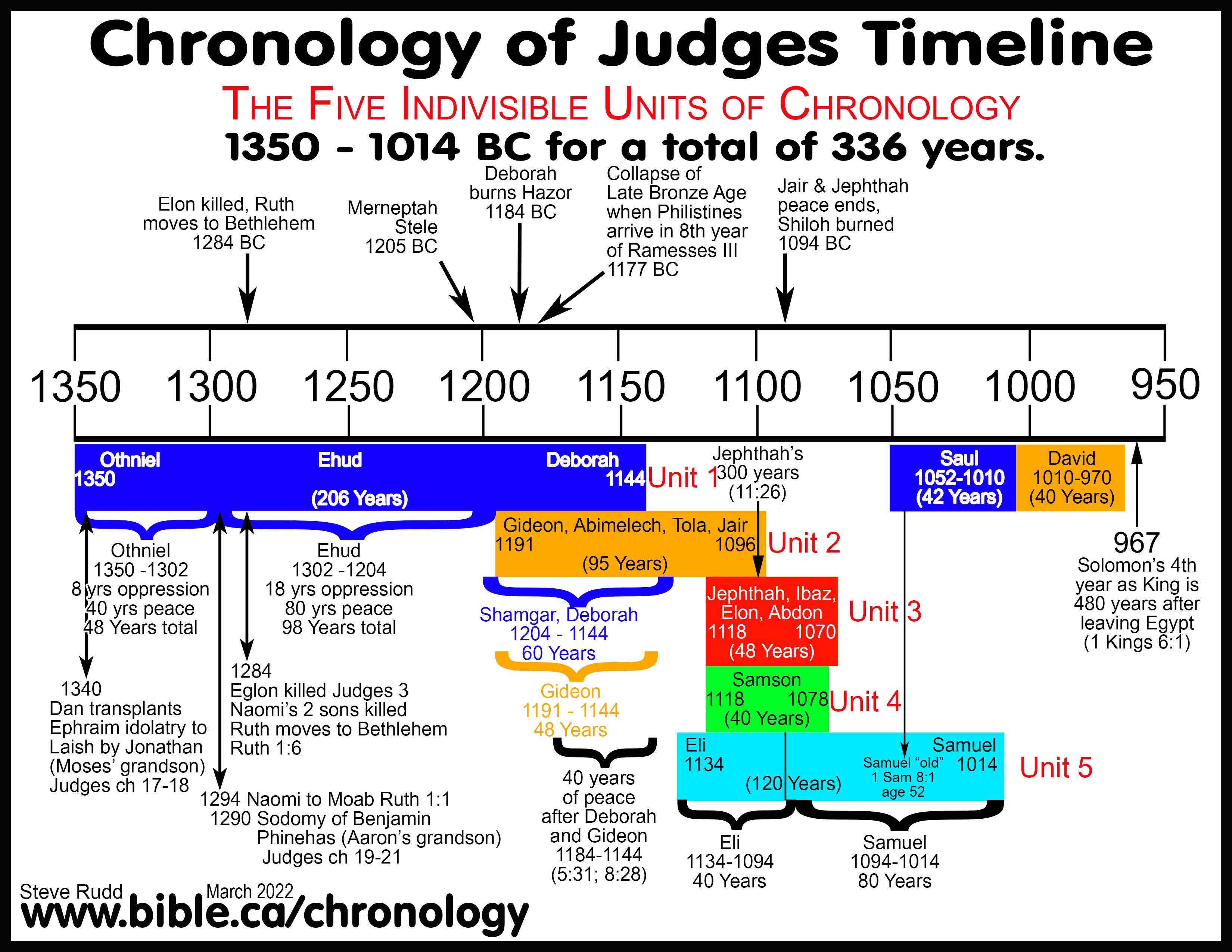
C. Indivisible Unit 1: Othniel, Ehud, Ruth to Deborah: 1350 - 1144 (206 years)
- The unit consists of periods of oppression and peace that are mutually exclusive. In other words, you cannot overlap a times of war and times of peace. While it is possible that in this first Unit, the times of war and peace are in different regions of Israel, we consider this unlikely given the natural reading of the text. It is also unnecessary.
- You have 8 years of oppression, followed by 40 years when the "land had rest", followed by 18 years of oppression, followed by 80 years when the "land had rest". There simply is no way to shorten this time by overlapping periods of oppression and peace within the unit.
- But a secondary factor comes into play within unit 1. It says, "after Ehud died came both Shamgar and Deborah". We know therefore, that both Shamgar and Deborah judged within the same period of chronological time side by side, and it is quite interesting that no dates are given for Shamgar. All we know is that Shamgar followed Ehud, as did Deborah who judged 40 years. So we can rightly ignore Shamgar in terms of the chronology since we know he judged during the same "post Ehud" period as Deborah, for whom we know the specific dates of her judgeship.
- The book of Ruth coincides with Ehud's liberation of
Eglon, king of Moab and the story of Benjamin's sodomy of Judges 19-21.
See harmony of Judges
and Ruth.
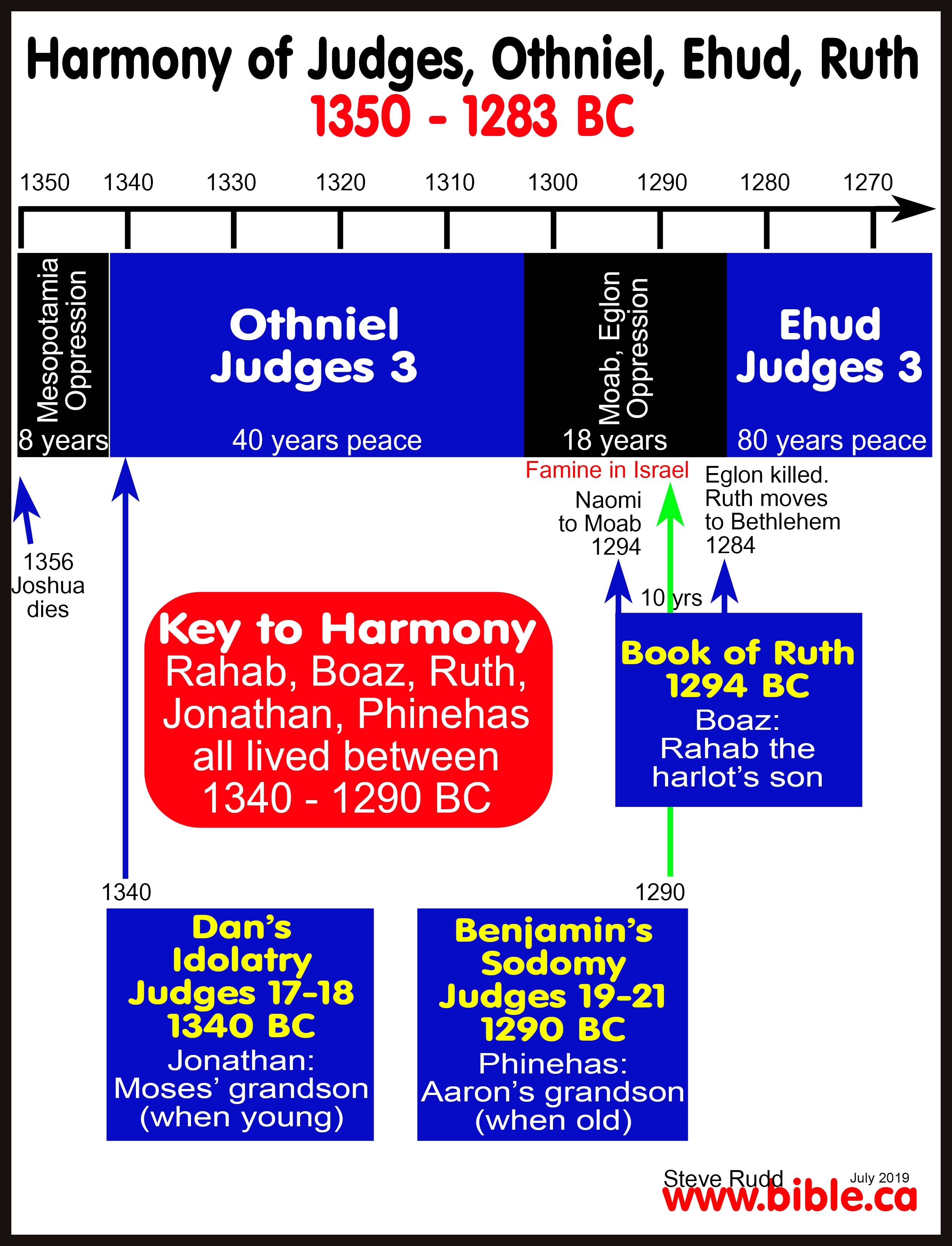
- The Merneptah
Stele (1205 BC) proves the late exodus date of 1250 BC to be wrong:
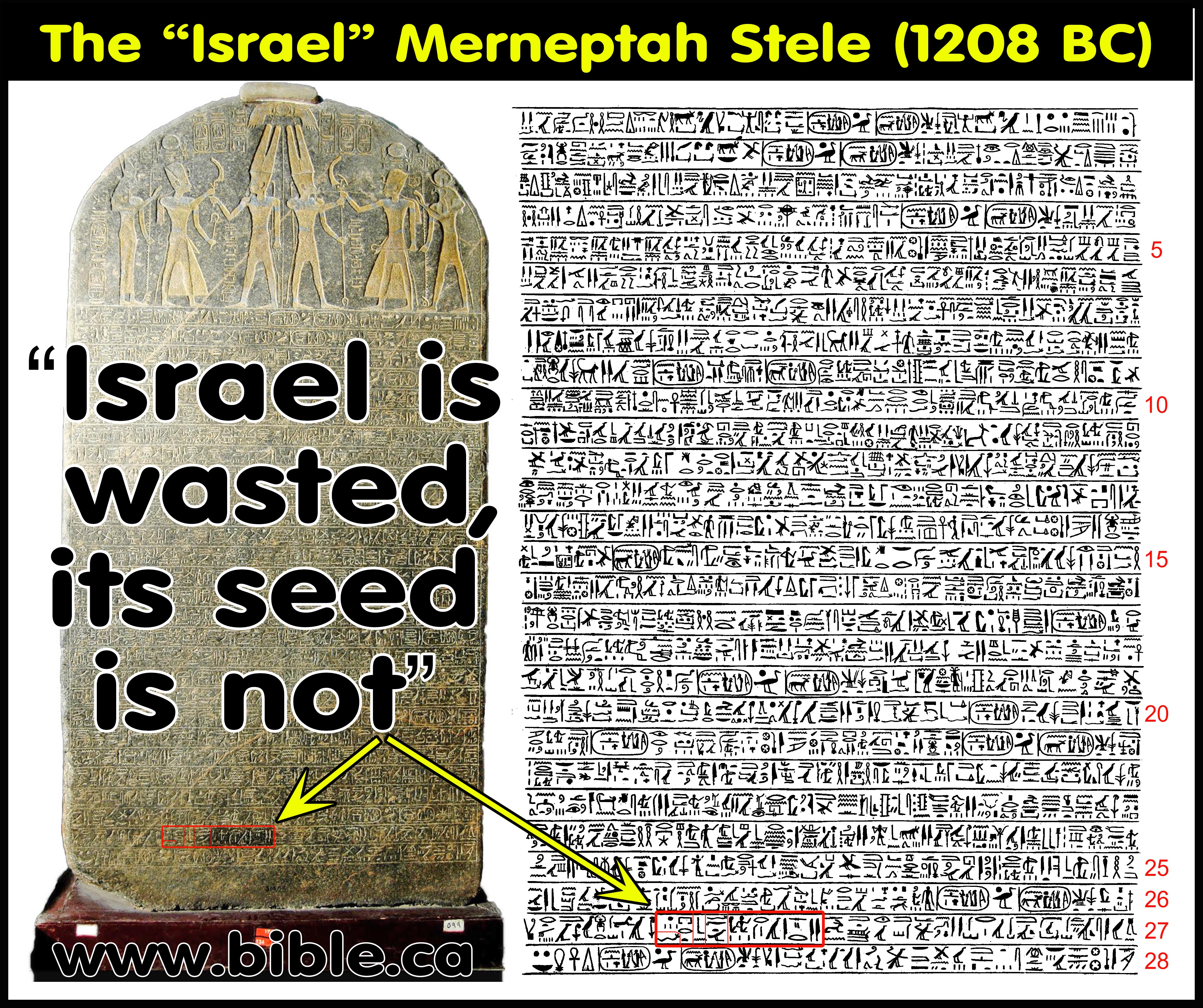
a. Pharaoh Merneptah was the son of the pharaoh Ramesses II (1279–1213 BC, low chronology).
b. Merneptah’s invasion in 1205 BC is a perfect synchronism for the chronology of the judges:
i. Ehud judged Israel for 98 years between 1302-1204 BC. There was an initial 18 years of oppression under the Moabites (Judges 3:14) between 1304-1286 BC. Then in 1284 BC Ehud killed Eglon and Israel experienced 80 years of peace ending in 1204 BC.
ii. From 1204-1184 BC, there were 20 years of oppression until Deborah kills Sisera, defeats Jabin and burns Hazor in 1184 BC. Archeologists have misdated the second burning of Hazor by 46 years too early at 1230 BC because they fail to mark the death of Joshua in 1356 BC.
iii. The beginning of the period of Israel’s oppression in 1204 BC one year later than when Merneptah attacked Israel in 1205 BC.
iv. Therefore, when we lay the archaeology of Merneptah Stele over top of the accepted chronology of the Judges, it is a perfect fit!
v. What you read in the book you find in the ground!
c. Merneptah refutes the late date of 1250 BC for the exodus and Ramesses II as the Pharaoh:
i. If Ramesses II is the pharaoh of the Exodus, then the date of the exodus is 1250 BC.
ii. If the exodus is 1250 BC then the conquest started in 1210 BC and was complete in 1203 BC.
iii. The 1250 BC exodus date is impossible because in 1205 BC, Merneptah boasts that he conquered Israel in the middle of the conquest of Joshua.
d. Since the exodus was really in 1446 BC, then the Merneptah Stele was created during the time of Deborah (Judges 4, 1204-1144 BC).
- Deborah burns Hazor in 1184 BC:
a. Joshua burned Hazor in 1401 BC and Deborah burned Hazor a second time in 1184 BC.
b. It has been known for some time that archeologists have misdated the second burning of Hazor by Deborah too early at 1230 BC because they fail to mark the death of Joshua in 1356 BC. Joshua was Moses’ “youth servant” and was 20 years old at Mt. Sinai in 1446 BC and lived at total of 120 years to die in 1356 BC.
c. From 1204-1184 BC, there were 20 years of oppression until Deborah kills Sisera, defeats Jabin and burns Hazor in 1184 BC.
- Bronze age ends in 1177 BC when the Philistines arrive in 1177 BC in the 8th year of Ramesses III.
D. Indivisible Unit 2: Gideon to Jair: 1191 - 1096 (95 years)
- Scripture gives a sequential narrative of one judge after the other in a train like string.
a. When you splice the different verses together you get this meaning: "First Gideon and the land was undisturbed 40 years (8:28). After Gideon came Abimelech who judged for 3 years (9:22). After Abimelech died Tola judged for 23 years (10:2). After Tola came Jair who judged for 22 years (10:3)".
b. It is obvious then that you cannot shorten the 95 years because each Judged after the prior one died.
- Abimelech must be included in the chronology.
a. Those who remove Abimelech from the chronology simply because he was not appointed by God are violating the context of the chronology given.
b. It matters not if Abimelech was approved by God or not, the fact remains that he judged for three years after Gideon in Shechem (9:22).
E. Indivisible Unit 3: Jephthah to Abdon: 1118 - 1070 (48 years)
- Like unit two, unit 3 has a sequential narrative of one judge after the other: "First Jephthah judged 6 years (12:7). After Jephthah then Ibzan judged 7 years (12:8). After Ibzan then Elon judged 10 years (12:9). After Elon then Abdon judged 7 years (12:14)".
- Each of these judges ruled one after the other like a train with four cars in a row.
- Like Unit 2, there is no way to reduce 48 years of Unit 3 because it is clear the judges did not rule at the same time.
F. Indivisible Unit 4: Samson: 1118 - 1078 (40 years)
- Now it is important to notice that there were 40 years of oppression by the Philistines and Samson judged 20. However, the oppression of the Philistines continued right through to the death of Samson. In other words, Samson did not succeed in defeating the Philistines until the day he died. So, we do not add the 20 years of Samson on top of the 40 years of Philistine oppression, because both ended at the same time.
- So, a total of 40 years, not 60 are to counted because Samson judged during the last 20 years of the 40 year Philistine oppression.
- Whether 40 or 60 years, it doesn't make any difference in the chronology of Judges because we can fit either in easily.
G. Indivisible Unit 5: Eli to Samuel: 1128 - 1014 (114 years).
1. Eli was born in 1192 BC and began judging Israel in 1134 BC.
a. Eli died in 1094 BC when the Philistines captured the Ark of the Covenant and Shiloh was burned.
b. Eli was 98 years old when he died (1 Sam 4:15) and he judged Israel 40 years (1 Sam 4:18).
c. Eli judged Israel 1134-1094 BC for a total of 40 years.
2. Samuel was born in 1102 BC and was 8 years old in 1094 BC when Eli died.
a. Samuel was a Kohathite priest (1 Chron 6:27-28; 33-34).
b. Samuel was the sole central theological authority of the 11th century BC where he ran a prophet’s school and converted the scriptures from its original “Mosaic-Hieroglyphic-Hebrew” into “Paleo-Hebrew” script.
c. He was he moral mentor and adviser of David from the time he was anointed at age 15 in Bethlehem to the time Samuel died in 1014 BC at the age of 92 years old.
d. Samuel judged Israel 1094-1014 BC for a total of 80 years.
|
NOTE 2: |
We have now defined each of the 5 "Indivisible Units". Let's now examine how one unit can be overlapped with another in order to reduce the time from 489 years to 336 years. |
H. Splicing Units 1 and 2 together:
- We can prove that Deborah and Gideon judged at the same time. After each Judge the narrative tells us there were two periods of 40 years where the land had rest. Most view these as two different sets of 40 years which they add up to 80 chronological years. However, these two periods of 40 years of rest are in fact the same period and amount to a total of only 40 chronological years. Therefore, we match the 40 years of rest of Gideon (8:28) with the 40 years of rest of Deborah (5:31) and it creates a close harmony with the 300 years of Jephthah in Judges 11:26.
- By lining up the two 40 years of peace, we very nicely splice the end of "indivisible unit 1", with the beginning of "indivisible unit 2".
- This shows us that Israel was being oppressed in the north by the Canaanites at the same time the Midianites were crossing the Jordan and raiding the crops of central Israel, then returning Transjordan.
- Deborah's battle was at Mt. Tabor and involved 10,000 men from the tribes of Naphtali and Zebulun: "the God of Israel, has commanded, 'Go and march to Mount Tabor, and take with you ten thousand men from the sons of Naphtali and from the sons of Zebulun." Judges 4:6.
- Gideon's battle started in the valley of Jezreel, then moved Transjordan far east of the Jordan and involved a specialized army of 300 from Manasseh, Asher, Zebulun, and Naphtali: "the Midianites and Amalekites and the sons of the east ... camped in the valley of Jezreel. ... Gideon ... called together to follow him: Manasseh, Asher, Zebulun, and Naphtali, and they came up to meet them." Judges 6:33-35.
- The critical link between Deborah and Gideon is in the tribes who fought and the tribes who refused to fight. Deborah started judging 13 years before Gideon and chastised the region of Gilead, and the tribes of Dan and Asher because they would not join in the battle: "Gilead remained across the Jordan; And why did Dan stay in ships? Asher sat at the seashore, And remained by its landings." Judges 5:17. She praises Zebulun and Naphtali for joining the battle: ""Zebulun was a people who despised their lives even to death, And Naphtali also, on the high places of the field." Judges 5:18
- When Gideon (from the tribe of Manasseh) started judging 13 years later, the same tribes fight and the same tribes refused! Gideon comes to two towns in Gilead (Succoth and Penuel) and asks the leaders for food to feed his army of 300 and they both refuse. (8:5-8) Gilead had previously refused Deborah's request for help at Mt. Tabor: "Gilead remained across the Jordan" Judges 5:17. So this was the second time Gilead had refused to fight for their brethren. After Gideon destroys Midian, he returns and destroys the town leaders of Gilead (Succoth and Penuel). A kind of "two strikes and you're out" policy with God. Later Gilead would redeem themselves under Jephthah, who himself was a Gileadite who saved themselves from the Ammonite oppression. Perhaps still not that noble, since they were merely defending their own home turf from the invasion of the king of Ammon. Good thing the Gileadites had no French genes in them, or else they would have just surrounded to the Ammonites and expected the other tribes to liberate an fight for them!
- So we can prove that Deborah and Gideon Judged at the same time because the same two tribes (Zebulun and Naphtali) willingly supplied valiant warriors and the Gilead refused both of them to fight. This is an enormous key to unlocking the chronology of Judges!
- Since Deborah and Gideon judged at the same time, then the 40 years of peace that followed both are identical and should be laid upon one another in chronological terms because they are concurrent.
I. Splicing Units 3 and 4 together:
- Samson and Jephthah were two judges that arose in different parts of the country at the same time. We can place Jephthah at 1100 BC (Judges 11:26) but we are unsure exactly where to place Samson.
- Judges 10:6-8 is a transitional text in the book of Judges that acts as an introduction to the next two Judges: Jephthah who defeated the Ammonites, and Samson who defeated the Philistines: "The anger of the Lord burned against Israel, and He sold them into the hands of the Philistines and into the hands of the sons of Ammon." Judges 10:7. This also proves that Jephthah and Samson judged at the same time because God sold them into the hands of two nations during a single period of his anger. Nothing could be clearer than this.
- Remember that Samson did not stop the 40-year oppression of the Philistines until the day he died. This means we include his 20-year judgeship inside the 40 years of Philistine oppression. The oppression and judgeship ended at the same time. Samson judged for 20 years, but the Philistine oppression of 40 years ran concurrently with his judgeship, because the Philistines were not routed until Samson died! This means that adding 20 years of judgeship time to 40 years of oppression time for a total time span of 60 is wrong. In fact from Samson, we can see that there were 20 years of oppression before Samson started judging. Then Samson judged 20 years during the final 20 years of Philistine oppression. Most make the mistake of viewing a period of 40 years of oppression that ended when Samson started judging and that the land had peace for the next 20 years.
- Also take note that Saul and David killed Goliath the Philistine in 1026 BC. The battles with the Philistines was an ongoing matter.
- Since we are told that Jephthah lived in 1100 BC, we will use "Indivisible unit 3": Jephthah - Abdon (48 years), from 1100 BC forward and basically ignore Samson. Samson should be placed directly on top of the Jephthah - Abdon chronology, although we cannot be sure exactly what dates are involved.
- We need to also remember that when Jephthah said it had been 300 years, this was after the Ammonites had already crushed Israel for 18 years from 1118 - 1100 BC. (10:8). We know that the "300 years" dates from the first year he was judge and the last year of the Ammonite oppression when he defeated them. This also means that Jair judged during the entire time of the Ammonite oppression and died in the fourth year that Jephthah was judge in 1096 BC.
- The oppression of the Ammonites was isolated to the Transjordan region of Gilead alone. Samson's judgeship centered around the Philistines at the modern Gaza strip area in the far south west. Jair was judge in the central and northern sections of Canaan. These three distinct geographic areas make it clear how Jair, Samson and Jephthah could be judges at the same time.
J. Splicing Unit 5 together: Eli and Samuel: 124 years.
1. Eli and Samuel are rather simple to synchronize.
a. Eli was born in 1192 BC
b. Eli lived to be 98 years old and "judged Israel forty years." 1 Samuel 4:15-18.
2. Samuel was born in 1102 BC and brought to Eli by Hanna after the boy was weaned at about age 5: "And his mother would make him a little robe and bring it to him from year to year when she would come up with her husband to offer the yearly sacrifice." 1 Samuel 2:19
a. The narrative seems to have Samuel living with Eli for about 3 years before God spoke to him at night and revealed that Eli and his sons would soon die. So Samuel was called to be a prophet when he was 8.
b. In 1094 BC, the Ark of the Covenant was captured, Eli and his two sons died and Shiloh was destroyed by the Philistines.
3. The bible says that "Samuel judged Israel all the days of his life." 1 Samuel 7:15.
a. So Both Eli and Samuel judges even though they are never mentioned in the book of Judges. Samuel was the last Judge.
b. Samuel was also confirmed to be a prophet at age 8 and Eli died that same year.
4. Samuel was described as an old man (52 years old) when he anointed Saul as the first "king" around 1052 BC and reigned 42 years: 1 Samuel 13:1
a. Samuel anointed David as a "youth" (15 years old). "Then Saul said to David, you are but a youth while he has been a warrior from his youth." 1 Samuel 17:33. David killed Goliath in 1025 BC, which was the 27th year of Saul's 42 year reign.
b. After Samuel died in 1014 BC, Saul consulted the witch of Endor in 1014 BC when Samuel told Saul he would die the following day: 1 Samuel 28:19.
5. The witch described Samuel as "an old man is coming up" 1 Samuel 28:14. So Samuel was an old man when he died.
6. Although the bible does not tell us how old Samuel was when he died, we grant Samuel 88 years, even though he could have lived to be 120 and it would really make no difference in calculating the overall Chronology of the Judges.
a. This means Samuel lived 88 years between 1102 -1014 BC.
b. Although the dates for Eli are dependent on the age that Samuel was when he died, it doesn't really change much. If Samuel lived to be 100 or 120 years, it just pushes back the year Eli died (and the destruction of Shiloh) earlier.
c. Nothing else is affected.
d. The date of the destruction of Shiloh is the only important variable that is affected by the age of Samuel when he died.
7. Therefore the "Eli to Samuel unit" is calculates this way:
a. 40 years Eli judged
b. Samuel was 8 years when Eli died in 1094 BC
c. Samuel judged Israel 80 years until he died in 1014 BC.
d. So for chronological purposes, Unit 5 has 120 years from the time of Eli judging to Samuel’s death.
8. Saul died the same year David started reigning as king in Hebron in 1010 BC.
K. The reigns of David and Solomon:
1. It is clear that the Exodus took place in 1446 BC. Those who believe the 1250 BC Exodus date must deny the inspiration of the scriptures.
2. There is almost universal agreement from scholars and archeologists that Solomon ruled from 970-931 BC
a. David was 30 years old when he became king and reigned a total of 40 years: 7.5 in Hebron and 33 in Jerusalem. (2 Samuel 5:4-5).
b. We know Solomon was born in 999 BC when David was 41 years old.
c. We also know Solomon became king in 970 BC at age 29.
d. We know Solomon died in 931 at age 69.
3. Three unknowns:
a. We know Samuel died in 1014 BC, but not his age when he died.
c. The age David was anointed by Samuel in Bethlehem is unknown, but he killed Goliath at age 15 so it may have been that same year.
4. We can get a basic idea of when Solomon as born by examining what David did first arriving in Jerusalem included:
a. building his palace and Millo (2 Samuel 5:9-11), and immediate wars with philistines (end of year one)
b. war with Ammonites and adultery with Bathsheba (end of year 2)
c. the death of first child (10 months), birth of Solomon (9 months) (end of year 4)
5. Using this calculation method, Solomon was born in the 4th - 5th year of the reign of David's reign at Jerusalem and who was age 40-41 at the time. Since David died at age 70, that means that Solomon began reigning when he was 29-30 years old.
6. David described Solomon as "young and inexperienced" just before he became king: 1 Chronicles 22:5; 29:1. Solomon describes himself when he became king: "I am but a little child; I do not know how to go out or come in." 1 Kings 3:7.
7. We will use 40 as the age of David when Solomon was born and 29 as the age of Solomon when he ascended the throne since God likes to use the round numbers of 30 and 40 so often in describing the events of the kings!
8. The Eli - Solomon Timeline:
L. The Exodus Timeline:
- The Pharaoh of the Exodus was Tuthmosis III: 1479 - 1425 BC
- Here is a detailed study of the Exodus Chronology Timeline.
M. Joshua was 20 years of age at Sinai in 1446 BC: Ex 33:11; Num 11:28
- Joshua was born in 1466 BC, was 20 years old at Mt. Sinai in 1446 BC and died at age 110 in 1356 BC.
a. “Thus the Lord used to speak to Moses face to face, just as a man speaks to his friend. When Moses returned to the camp, his servant Joshua, the son of Nun, a young man, would not depart from the tent.” (Exodus 33:11)
b. “Then Joshua the son of Nun, the servant of Moses from his youth, said, “Moses, my lord, restrain them.” (Numbers 11:28)
- The death of Joshua in 1356 BC is a critical anchor point for beginning the Chronology of the Judges.
a. Some set the death of Joshua at 1384 BC and a date of 1378 BC for the oppression of Cushan-Rishathaim king of Mesopotamia (Josh 3:8).
i. “To begin the determination of the dating, Joshua seemingly died in ca. 1384 BC.” (Dating of Hazor’s destruction in Joshua 11, Douglas Petrovich, JETS 51/3, p494, 2008 AD)
b. This 29-year error has the direct effect of shifting the entire Chronology of the Judges 29 years earlier than it should be.
c. This 29-year error causes dissonance with the date Deborah burned Hazor, the Merneptah Stele, the collapse of the Late Bronze age with the mass arrival of the Philistines, the burning of Shiloh and the birth of King David.
i. “The simple (and biblical) solution is that Joshua destroyed an earlier city at Hazor in ca. 1400 BC, while Deborah and Barak administered the coup de grâce in ca. 1230 BC.” (Rise and Fall, Bryant Wood, JETS 48:3, p488, 2005 AD)
- Although Joshua was not older than 20 years old at Sinai, he must have been no less than 20 years old at Kadesh Barnea, 2 years later, to be excepted from the 20 years and older will die in the wilderness edict:
a. “your corpses will fall in this wilderness, even all your numbered men, according to your complete number from twenty years old and upward, who have grumbled against Me. ‘Surely you shall not come into the land in which I swore to settle you, except Caleb the son of Jephunneh and Joshua the son of Nun.” (Numbers 14:29-30)
b. If Joshua was only 19 years old, there would have been no need to make the specific exception here.
c. So we can be certain that Joshua was at least 20 years old at Kadesh when the spies were sent out.
d. This sets the lowest possible age of Joshua at Sinai at 18 years old.
- We can be certain that Caleb was 38 years old at Sinai and 40 years when he was chosen as one of the twelve spies sent from Kadesh Barnea:
a. “I was forty years old when Moses the servant of the Lord sent me from Kadesh-barnea to spy out the land, and I brought word back to him as it was in my heart. … Now behold, the Lord has let me live, just as He spoke, these forty-five years, from the time that the Lord spoke this word to Moses, when Israel walked in the wilderness; and now behold, I am eighty-five years old today. “I am still as strong today as I was in the day Moses sent me; as my strength was then, so my strength is now, for war and for going out and coming in.” (Joshua 14:7,10-11)
b. Joshua 14:10-11 tells us that Moses promised Caleb the Hebron area as an inheritance when he returned from spying out the land.
c. They left Egypt in 1446 BC and after 45 days, they arrived at Sinai. They spent 11 months at Sinai. Then they travelled between Sinai and Kadesh and arrived exactly two years after leaving Goshen in 1444 BC.
d. 85-45 years = 40 years. Caleb was 40 years old at Kadesh when the 12 spies were sent out in 1444 BC.
e. After returning from spying out the land, Caleb spent 38 years at Kadesh before crossing the Zered Wadi which triggered the start of the conquest in 1406 BC.
f. 40 + 38 = 78 Years old when the Conquest started in 1406 BC.
g. 85 - 78 = 7 year is how long the conquest took.
h. Caleb was 85 years old in the 7th and last year of the conquest in 1399 BC.
- Quick summary of Hebrew words used in this study:
a. "bâchurowth": Hebrew word meaning a "youth" used three times in the OT.
b. "sharath": Hebrew word meaning a "servant" used 97 times in the OT.
c. "naʿar": Hebrew word meaning an "infant, child, lad, youth" used 200 times in the OT. Sometimes translators rendered it "servant" indicating that they were "child servants" of a prophet or master.
- The Hebrew word, bâchurowth is only used three times in the Old Testament and always indicates a young man in the natural sense of the word. “Then Joshua the son of Nun, the servant [sharath] of Moses from his youth [bâchurowth], said, “Moses, my lord, restrain them.” (Numbers 11:28)
a. “Rejoice, young man, during your childhood, and let your heart be pleasant during the days of young [bâchurowth] manhood. And follow the impulses of your heart and the desires of your eyes. Yet know that God will bring you to judgment for all these things. So, remove grief and anger from your heart and put away pain from your body, because childhood and the prime of life are fleeting. Remember also your Creator in the days of your youth [bâchurowth], before the evil days come and the years draw near when you will say, “I have no delight in them”. (Ecclesiastes 11:9–12:1)
b. The usage of the word in Ecclesiastes would indicate a man 20 and under. This is how it has always been applied historically in the church.
- The Hebrew word naʿar, is used over 200 times in the Old Testament and always indicates an infant, child or young man in the natural sense of the word. “Thus the Lord used to speak to Moses face to face, just as a man speaks to his friend. When Moses returned to the camp, his servant Joshua, the son of Nun, a young [naʿar] man, would not depart from the tent.” (Exodus 33:11)
a. Joshua chose two young men to spy out Jericho, make a covenant with Rahab and return with a report. It would make perfect sense to send youths as spies because they would not attract attention like older men would: “Joshua said to the two men who had spied out the land, “Go into the harlot’s house and bring the woman and all she has out of there, as you have sworn to her.” So the young [naʿar] men who were spies went in and brought out Rahab and her father and her mother and her brothers and all she had; they also brought out all her relatives and placed them outside the camp of Israel.” (Joshua 6:22-23)
b. “God heard the lad [naʿar] crying; and the angel of God called to Hagar from heaven and said to her, “What is the matter with you, Hagar? Do not fear, for God has heard the voice of the lad [naʿar] where he is.” (Genesis 21:17)
c. “Joseph, when seventeen years of age, was pasturing the flock with his brothers while he was still a youth [naʿar], along with the sons of Bilhah and the sons of Zilpah, his father’s wives. And Joseph brought back a bad report about them to their father.” (Genesis 37:2)
d. “We have an old father (Jacob) and a little child (Benjamin) of his old age. Now his brother is dead, so he alone is left of his mother, and his father loves him.’ “Then you said to your servants, ‘Bring him down to me that I may set my eyes on him.’ “But we said to my lord, ‘The lad [naʿar] cannot leave his father, for if he should leave his father, his father would die.’” (Genesis 44:20–22)
e. “When she opened it, she saw the child (Moses), and behold, the boy [naʿar] was crying. And she had pity on him and said, “This is one of the Hebrews’ children.”” (Exodus 2:6)
- Joshua was the "servant and attendant of Moses from his youth" Joshua's role as a personal servant: Exodus 24:13, 33:11, Joshua 1:1, 11:15, Judges 2:8. This is perhaps the most powerful proof he was young because it is part of a pattern of very young men serving prophets and kings. In fact, many times the Hebrew word for "youth" [naʿar] changed to "servant" by the English translators. There is another word for servant [sharath] that is used 97 times for a "servant" without reference to youth.
a. Joshua was Moses's youth servant:
i. Note: although Joshua is never called the "naʿar" of Moses" (youth of Moses), he is twice described as being a young man who served Moses FROM HIS YOUTH.
ii. “So Moses arose with Joshua his servant [sharath], and Moses went up to the mountain of God.” (Exodus 24:13)
iii. “Thus the Lord used to speak to Moses face to face, just as a man speaks to his friend. When Moses returned to the camp, his servant [sharath] Joshua, the son of Nun, a young man, would not depart from the tent.” (Exodus 33:11)
iv. “Then Joshua the son of Nun, the servant [sharath] of Moses from his youth [bâchurowth], said, “Moses, my lord, restrain them.” (Numbers 11:28)
v. “Now it came about after the death of Moses the servant of the Lord, that the Lord spoke to Joshua the son of Nun, Moses’ servant [sharath], saying,” (Joshua 1:1)
vi. “Just as the Lord had commanded Moses his servant, so Moses commanded Joshua, and so Joshua did; he left nothing undone of all that the Lord had commanded Moses.” (Joshua 11:15)
vii. “Then Joshua the son of Nun, the servant [sharath] of the Lord, died at the age of one hundred and ten.” (Judges 2:8)
b. Abraham's youth servant: “Abraham said to his young [naʿar] men, “Stay here with the donkey, and I and the lad [naʿar] will go over there; and we will worship and return to you.”" (Genesis 22:5)
c. Potiphar's youth servant: “So Joseph (aged 17-18) found favor in his sight and became his personal servant [sharath]; and he made him overseer over his house, and all that he owned he put in his charge.” (Genesis 39:4) ““Now a Hebrew youth [naʿar] was with us there, a servant [sharath] of the captain of the bodyguard, and we related them to him, and he interpreted our dreams for us. To each one he interpreted according to his own dream.” (Genesis 41:12)
d. Abraham's youth servant: “Then Absalom called his young [naʿar] man who served [sharath] him and said, “Now throw this woman out of my presence, and lock the door behind her.”” (2 Samuel 13:17)
e. Balaam's 2 youth servants: “Now he (Balaam) was riding on his donkey and his two servants [lit: youths, naʿar] were with him.” (Numbers 22:22)
f. Gideon's youth servant: “But if you (Gideon) are afraid to go down, go with Purah your servant [lit: youth, naʿar] down to the camp,” (Judges 7:10)
g. Abimelech's youth servant: “Then he (Abimelech) called quickly to the young [naʿar] man, his armor bearer, and said to him, “Draw your sword and kill me, so that it will not be said of me, ‘A woman slew him.’ ” So the young [naʿar] man pierced him through, and he died.” (Judges 9:54)
h. Sampon's youth servant: “Then Samson said to the boy [naʿar] who was holding his hand, “Let me feel the pillars on which the house rests, that I may lean against them.”” (Judges 16:26)
i. Levite's youth servant: “Then her husband arose and went after her to speak tenderly to her in order to bring her back, taking with him his servant [lit: youth, naʿar] and a pair of donkeys.” (Judges 19:3)
j. Jonathan's youth servant at Geba: “Now the day came that Jonathan, the son of Saul, said to the young [naʿar] man who was carrying his armor, “Come and let us cross over to the Philistines’ garrison that is on the other side.” But he did not tell his father.” (1 Samuel 14:1)
k. Jonathan's youth servant at Gibeah: “Now it came about in the morning that Jonathan went out into the field for the appointment with David, and a little lad [naʿar] was with him.” (1 Samuel 20:35)
l. Amalekite's youth servant: “David said to him, “To whom do you belong? And where are you from?” And he said, “I am a young [naʿar] man of Egypt, a servant [sharath] of an Amalekite; and my master left me behind when I fell sick three days ago.” (1 Samuel 30:13)
m. Solomon's youth servant: “Now the man Jeroboam was a valiant warrior, and when Solomon saw that the young [naʿar] man was industrious, he appointed him over all the forced labor of the house of Joseph.” (1 Kings 11:28)
n. Elijah's youth servant: “He said to his servant [lit: youth, naʿar], “Go up now, look toward the sea.” So he went up and looked and said, “There is nothing.” And he said, “Go back” seven times.” (1 Kings 18:43)
- The 12 spies that were sent from Kadesh Barnea were leaders within their tribal clan and were likely older men. For example Caleb was 40 when he was chosen to spy out the land from Kadesh about 2 years after leaving Sinai. How do we explain the fact that Joshua was a 20-year-old clan leader?
a. As Moses' personal servant it would be natural for the tribe of Ephraim to choose Joshua as their tribal representative. Although not an "older" leader, like the others probably were, he would get significant special consideration for his very special rose as Moses personal servant.
b. Also, Joshua had in fact shown leadership when Moses asked him to gather the troops to battle the Amalek just before reaching Sinai: “So Moses said to Joshua, “Choose men for us and go out, fight against Amalek. Tomorrow I will station myself on the top of the hill with the staff of God in my hand.” Joshua did as Moses told him, and fought against Amalek; and Moses, Aaron, and Hur went up to the top of the hill.” (Exodus 17:9-10)
c. So for a period of almost two years, Joshua had shown leadership not only as Moses' servant, relaying commands, he had also fought victoriously against the Amalekites.
- Caleb was 38 years old at Sinai and Joshua was about 20. Why would God give more responsibility to a younger man? Doesn't this argue that Joshua must have been older than Caleb? For example, some suggest Joshua died in 1384 BC (at the age of 110), which would make him 62 years old at Sinai in 1446 BC.
a. There are many examples in scripture where God chose young men to do great things: Joseph, Samuel was a leader from infancy. Jonathan was 15 when he defeated the Philistines at Geba. David was 15 when he killed Goliath. Josiah was king at 8. Joshua fits a pattern of remarkable young men.
b. The real question is why did God/Moses chose Joshua over Caleb to be his personal servant?
c. What good is a successor that dies a few years afterwards? In fact, given the fact that Joshua was Moses' successor, you would expect God to find the youngest possible man available, since this would mean he would rule the people for a long time after spending 38 more years at Kadesh, and then rule the people in Canaan.
- Some make Joshua as old as 62 years of age at Sinai have to find some way of explaining why Joshua is called "young". Their solution, is to make this relative to the age of Moses rather than actually being a young man in the natural sense. Therefore Joshua was "younger" at 62 than Moses who was 80. This seems unlikely for the following reasons:
a. 62 years old compared to 80 is only a small difference of 18 years.
b. There is no indication in either of the two texts that there is some comparison with Moses' age.
c. Num 11:28 is not comparative with Moses' age and clearly indicate that Joshua served Moses from the time of HIS youth, in the natural sense of the expression.
- Some feel that since Joshua was described as "old and advanced in years" and Caleb "still as strong today as I was in the day Moses sent me", that this proves Joshua was older than Caleb in 1393 BC.
a. In the 7th year of the conquest (1393 BC), Caleb was 85 and Joshua was 67 years old.
b. “Now Joshua was old and advanced in years (67) when the Lord said to him, “You are old and advanced in years, and very much of the land remains to be possessed.” (Joshua 13:1)
c. "I (Caleb) am eighty-five years old today. “I am still as strong today as I was in the day Moses sent me; as my strength was then, so my strength is now, for war and for going out and coming in.” (Joshua 14:7,10-11)
d. Moses was described the same way when he was 120 years old: “Although Moses was one hundred and twenty years old when he died, his eye was not dim, nor his vigor abated.” (Deuteronomy 34:7)
e. It is rather natural for a 67-year-old man to be described as "old and advanced in years".
f. The conclusion that Caleb must have been older than Joshua based upon these comparative statements is invalid and not well thought out.
- In our Chronology, we need also to add about 6 years after the death of Joshua before we start the first period of oppression. This is because Israel remained faithful until the elders who were alive in 1446 when they witnessed the 10 plagues and crossed the Red Sea had died.
a. “It came about after these things that Joshua the son of Nun, the servant of the Lord, died, being one hundred and ten years old. And they buried him in the territory of his inheritance in Timnath-serah, which is in the hill country of Ephraim, on the north of Mount Gaash. Israel served the Lord all the days of Joshua and all the days of the elders who survived Joshua, and had known all the deeds of the Lord which He had done for Israel.” (Joshua 24:29-31)
b. Assumptions that need to be considered include:
i. Joshua lived to be 110 years old. Did the "survivors" live to be 120?
ii. Were they ineffective in the last 5 years of their life due to typical ailments of old age?
iii. What kinds of regional decay (if any) had already set into areas outside Joshua's control?
iv. How many years lapsed after these men died before Israel went into apostasy.
- Joshua was no older than about 20 years of age at Sinai. This means that the "elders who survived him and witnessed (knew) the miracles in Egypt" would be at least 5 years old in 1446 BC when they crossed the Red Sea. Someone younger would probably not remember much.
- Regardless of Joshua's age at Sinai, only those under the age of 20 could cross the Jordan.
- Under all circumstances, only those born 15 years after Joshua (those age 5 in the exodus) would be included among those who survived him.
- When we add the possibility that some of these outlived Joshua past 110 years of age and subtract the effect that senility and old age might have had on their effectiveness in old age, we consider this to be a wash. We might add 5 years for those who lived to be 115 but subtract 5 years because many are not functional the last year years of their life. The net difference is zero in these two variables.
- On the other hand, even if none of the survivors lived to older than 105 years old, this would mean that we need only add 10 years to the period Israel remained faithful after Joshua died. It is our assumption that generally, while these elders outlived Joshua, they did not reach the age of 110 years as Joshua did.
- Joshua was no younger than 18 and no older than 20 at Sinai. Therefore, the 8 year oppression of Aram-naharaim (3:8) began in 1350 BC or 6 years after Joshua died.
Conclusion:
1. The chronology of the Judges fits almost perfectly from Othniel, the first Judge, down to Jephthah in 1100 BC.
2. The chronology of the Judges from Jephthah down to Solomon also fits almost perfectly within 6 years.
3. In proving the exodus of 1446 BC, we can use the Jephthah to Solomon Chronology in this way:
a. According to Judges 11:26-28, Jephthah lived 300 years after Israel crossed the Jordan which is 1100 BC.
b. Solomon's 4th year as king was 480 years after Israel left Egypt and 140 years after Jephthah.
c. The period of the Judges ended when David became king in 1010 BC, since Samuel judged until he died in 1014 BC.
4. If we take the raw chronological numbers from the book of Judges we get this:
a. Jephthah 6 years + Ibzan 7 years + Elon 10 years + Abdon 7 years + Eli 40 years + Samuel 80 years (who died in 1014 BC) + 4 years till Saul died and David became king in Hebron + 40 years of David + 4 years of Solomon = 198 years.
b. Unadjusted it is only 58 years too long. (Remember the Bible tells us plainly that Samson judged at the same time as Jephthah, so we don't count Samson or the oppression that preceded him.)
c. But we also know that Eli judged from 1134 - 1094 BC which was before Jephthah!
d. We can actually ignore 28 of the 40 years Eli judged. (1100-1134 = 34. 40-34 = 6)
e. Adjusted, we can subtract 34 years from 58 years and arrive at a net difference of only 24 years [58-34].
f. That’s amazing! Who said you can’t make sense of the Chronology in the book of Judges?
5. Using Jephthah’s 300 years to confirmation of an exodus in 1446 and conquest of 1406 BC:
a. The exodus was in 1446 BC.
b. Subtract 40 years wandering in the wilderness until they crossed the Jordan.
c. Subtract Jephthah's 300 years.
d. Subtract the 133 years forward from Jephthah (1100 BC) to the 4th year of Solomon (967 BC).
e. From the Exodus to the 4th year of Solomon = 40 + 300 + 133 = 473 years
f. 1 Kings 6:1 says the actual period was 480 years.
g. Using Jephthah’s 300 years and the Chronology of Steven Rudd, the difference is only 7 years! This is a stunning confirmation of the statement in 1 Kings 6:1 that the exodus happened 480 years before the 4th year of Solomon.
6. It clearly refutes the 1250 BC exodus.
a. All this makes it utterly impossible for the Bible believer to teach the exodus took place in 1250 BC. Trust your Bible, not Bible trashing archeologists who teach a 1250 BC exodus.
7. The Exodus took place in 1446 BC.
8. Trust Bible. It is the inspired word of God! Amen!
|
NOTE 3: |
Calculation #1: Jephthah’s 300 years calculation: 7-year difference Using the Judges Chronology of Steven Rudd conceived in 2006 AD, the difference is only 7 years! This is a stunning confirmation of the statement in 1 Kings 6:1 that the exodus happened 480 years before the 4th year of Solomon.
Calculation #2: Add each unit: Zero-year difference 1 Kings 6:1 Exodus to Solomon’s 4th year = 480 Years 1. Exodus to Conquest: 40 years (1446-1406 BC) 2. Conquest to death of Joshua: 50 years (1406-1356 BC) 3. Death of Joshua to first Judge: 6 years (1356-1350 BC) 4. First Judge to death of Samuel: 336 years (1350-1014 BC) 5. Death of Samuel to Death of Saul/David king: 4 years (1014-1010 BC) 6. David king 40 years (1010-970 BC) 7. Temple Year 4 of Solomon (970-967 BC) 40 + 50 + 6 + 336 + 4 + 40 + 4 = 480 years = 1 Kings 6:1 |
By Steve Rudd: Contact the author for comments, input or corrections.

